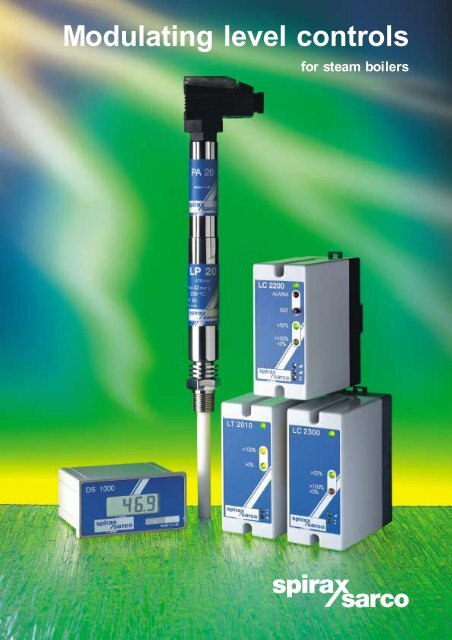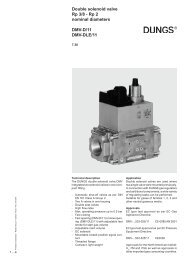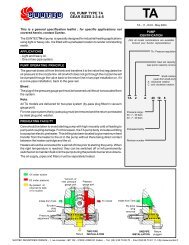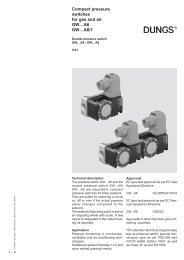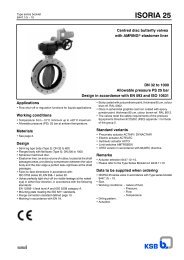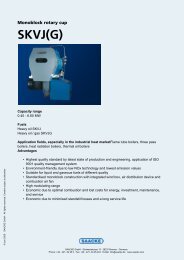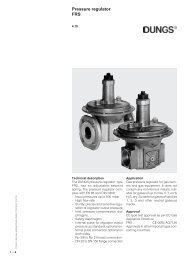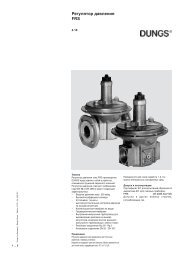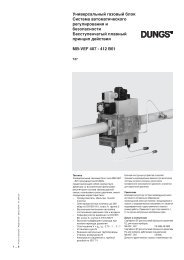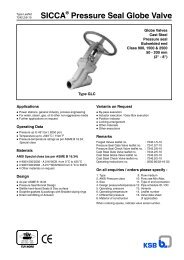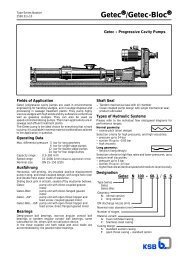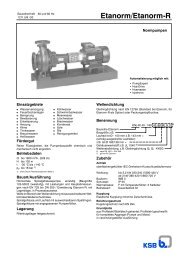Modulating level controls - Filter
Modulating level controls - Filter
Modulating level controls - Filter
Create successful ePaper yourself
Turn your PDF publications into a flip-book with our unique Google optimized e-Paper software.
<strong>Modulating</strong> <strong>level</strong> <strong>controls</strong><br />
for steam boilers
2<br />
The background to steam boiler<br />
water <strong>level</strong> <strong>controls</strong><br />
Originally the water <strong>level</strong> in a steam boiler was<br />
controlled by the boiler attendant regulating the<br />
feedwater inlet valve by hand whilst watching the<br />
water <strong>level</strong> in the gauge glass.<br />
The number of fatal accidents caused by boiler<br />
explosions due to low water <strong>level</strong>s was the main<br />
reason for regulations that required automatic<br />
<strong>controls</strong> and alarms to be fitted. This brochure<br />
concentrates on the automatic <strong>controls</strong>. Separate<br />
literature is available showing the range of Spirax<br />
Sarco high and low <strong>level</strong> boiler water <strong>level</strong> alarms.<br />
The on/off boiler plant<br />
Feedwater on / off<br />
Boiler feed check valve<br />
Feedpump<br />
The modulating boiler plant<br />
Feedwater<br />
flowrate matches<br />
steam demand<br />
Feedwater control valve<br />
Feedpump<br />
Crown valve<br />
Boiler feed check valve<br />
Steam flowrate<br />
Water <strong>level</strong> control and the<br />
on-off boiler plant<br />
As modern steam boiler design has progressed, the<br />
water volume and water surface area relative to the<br />
evaporation rate have decreased. The result is a highly<br />
efficient, low priced package that will work well if it is<br />
controlled smoothly.<br />
Indeed, Spirax Sarco can provide a range of on-off<br />
<strong>level</strong> <strong>controls</strong> which are detailed in separate literature,<br />
but they are not always the ideal mode for boiler<br />
water <strong>level</strong> control.<br />
In many installations, the on-off feedwater <strong>controls</strong><br />
can seriously affect the smooth operation of the boiler,<br />
having effects on boiler pressure, steam flowrate and<br />
burner firing rate.<br />
These effects are explained in more detail on page 3.<br />
Gauge glass<br />
Bottom blowdown valve<br />
Crown valve<br />
Fuel<br />
Steam flowrate<br />
Water <strong>level</strong> up and down<br />
Firing rate varies<br />
Gauge glass<br />
Bottom blowdown valve<br />
Fuel<br />
Water <strong>level</strong><br />
more steady<br />
Steady firing<br />
rate
On-off <strong>level</strong> <strong>controls</strong><br />
The water <strong>level</strong> is maintained by switching the<br />
feedpump on and off between two <strong>level</strong>s, typically<br />
50 mm apart. With the pump off, the burner will be<br />
firing to supply the steam load and maintain the boiler<br />
pressure. When the water <strong>level</strong> drops to the 'pump on'<br />
<strong>level</strong> the pump delivers a high flowrate of relatively<br />
cold feedwater that douses the boiler, reducing the<br />
steam flowrate and causing a drop in the boiler<br />
pressure. When the feedpump stops, the pressure<br />
and steam flowrate will increase and the burner will<br />
have to reduce its firing rate. The pump on-off control<br />
therefore causes cycling of the steam output. If the<br />
steam flowrate is recorded the effect can be seen<br />
from the saw tooth plot below.<br />
The steam flowrate peaks will tend to increase carryover<br />
of boiler water with the steam. Production processes<br />
can suffer.<br />
The continual cycling of the boiler <strong>controls</strong> will increase<br />
maintenance, reduce combustion efficiency and<br />
increase the thermal stresses on the boiler.<br />
1 PM<br />
13<br />
1 PM<br />
13<br />
2 PM<br />
14<br />
Steam flowrate from a boiler<br />
with on-off <strong>level</strong> <strong>controls</strong><br />
2 PM<br />
14<br />
3 PM<br />
15<br />
3 PM<br />
15<br />
4 PM<br />
16<br />
4 PM<br />
16<br />
5 PM<br />
17<br />
5 PM<br />
17<br />
Steam flowrate from a boiler<br />
with modulating <strong>level</strong> <strong>controls</strong><br />
<strong>Modulating</strong> <strong>level</strong> <strong>controls</strong><br />
The water <strong>level</strong> is maintained by a proportional<br />
controller regulating a valve in the feedwater line with<br />
a continuously running feedpump.<br />
This system works smoothly, is suited to nearly all<br />
boilers, large and small, and matches the feedwater<br />
flowrate to the steam demand.<br />
Boiler lock-outs<br />
The modulating <strong>level</strong> <strong>controls</strong> detailed in this pamphlet<br />
are sometimes termed 'single element'. The advantages<br />
of single element modulating <strong>level</strong> control over on-off<br />
control have been outlined above, and they are better<br />
able to follow sudden load changes.<br />
However, on boilers with very variable loads, even<br />
modulating control can result in boiler lock-outs. This<br />
is due to the well known phenomenon that the water<br />
<strong>level</strong> in a steam boiler increases due to the increased<br />
quantity of steam bubbles in the boiler below the water<br />
surface. The effect is sometimes referred to as 'swell'.<br />
Thus on a boiler operating with very variable loads, the<br />
increasing water <strong>level</strong> reduces the feedwater supply<br />
just when it should be increasing to match the increasing<br />
steam demand.<br />
The solution is to use a steam flowmeter signal as a<br />
feed forward input to the <strong>level</strong> controller to automatically<br />
compensate for the effect of swell. This is called two<br />
element control.<br />
Where the differential pressure across the feedwater<br />
valve varies, due perhaps to several boilers served by<br />
a common feedwater system, it may be necessary to<br />
introduce a third signal from a feedwater flowmeter -<br />
three element control.<br />
Spirax Sarco are able to offer advice and equipment for<br />
two and three element <strong>level</strong> control systems.<br />
3
4<br />
The optimum <strong>level</strong> control system<br />
Preamplifier housing probe electronics<br />
Level probe fitted in protection tube in boiler shell<br />
to reduce the effects of turbulence and foaming<br />
How the system works<br />
The controller receives a water <strong>level</strong> signal from the<br />
<strong>level</strong> probe. This is compared with the set point in<br />
the controller to produce an 'error signal'. Depending<br />
on the polarity (+ or -) of the error signal one or other<br />
of the control relays in the controller is energised to<br />
open or close the modulating feedwater valve. With<br />
electrically actuated valves a feedback potentiometer<br />
in the modulating valve actuator continuously signals<br />
the valve position and the controller continues to<br />
energise the actuator until the valve position is<br />
proportional to the error signal. In this way<br />
proportional <strong>level</strong> control is achieved.<br />
In practice the valve will find a steady position and<br />
make small adjustments from time-to-time to maintain<br />
the water <strong>level</strong>. Internal damping of the water <strong>level</strong><br />
signal and a built-in 'dead-band' prevent over frequent<br />
valve movements.<br />
Internally or externally<br />
mounted <strong>controls</strong>?<br />
The historical development of <strong>level</strong> <strong>controls</strong><br />
determined that float operated units mounted in<br />
external chambers became the standard. It has been<br />
usual to fit a sequencing purge valve to let the steam<br />
and water through the connections to keep them<br />
clear and to test the alarms. However with the advent<br />
of self-monitoring <strong>level</strong> alarms there is a strong<br />
argument for mounting both the <strong>level</strong> <strong>controls</strong> and<br />
alarms directly in the boiler shell to detect the water<br />
where it really matters - above the heated tubes.<br />
The Spirax Sarco <strong>level</strong> probe is suitable for mounting<br />
in external chambers or directly in the boiler shell<br />
within a protection tube.<br />
Adjustable high<br />
or low <strong>level</strong> alarm<br />
Adjustable<br />
set point<br />
Transmitter 100 %<br />
Valve closed<br />
Adjustable<br />
proportional<br />
band<br />
Valve open<br />
Transmitter 0 %<br />
Boiler fitted with probes directly mounted in shell
Adjustable<br />
transmitter range<br />
(typically boiler<br />
<strong>level</strong> gauge glass)<br />
LC2200 controller (LC2300 for<br />
pneumatically actuated valves)<br />
Green LED power on<br />
Red LED<br />
Test button<br />
For remote <strong>level</strong> signal transmission (optional)<br />
Green LED indicates <strong>level</strong> is above the set point<br />
Amber LED indicates <strong>level</strong> is outside the proportional band<br />
Alarm set point adjuster<br />
Level set point adjuster<br />
Proportional band adjuster<br />
Mounting position for probe in Spirax Sarco C2<br />
side chamber with sequencing purge valve<br />
Level transmitter<br />
4 - 20 mA to management system<br />
or remote indicator<br />
Purpose designed boiler feed check valve with<br />
soft seat to provide tight shut-off<br />
Digital<br />
display<br />
unit<br />
Electrically actuated modulating feedwater valve.<br />
Pneumatically actuated valves also available.<br />
User benefits<br />
Power on<br />
Span<br />
Zero<br />
Span adjust<br />
Zero adjust<br />
• <strong>Modulating</strong> system gives steady feedwater<br />
flowrate matched to steam demand<br />
• Can provide information to management systems<br />
• Can be used as direct replacement for old and<br />
outdated <strong>controls</strong> (modulating and on-off)<br />
• Three stage <strong>level</strong> wave filter to maintain<br />
a stable signal.<br />
• Out of range alarm checks for damage to wiring<br />
or probe, or incorrect wiring.<br />
• No need to depressurise boiler to change<br />
probe electronics<br />
5
6<br />
LP20 probe and<br />
PA20 preamplifier<br />
The LP20 probe consists of a stainless steel rod<br />
completely insulated from the water by PTFE. As the<br />
water <strong>level</strong> rises the capacitance between the rod and<br />
the earthed boiler protection tube or probe chamber<br />
increases. The capacitance is measured by the<br />
preamplifier and is transmitted as a dc signal to the<br />
controller. Control and alarm <strong>level</strong>s are set in the<br />
controller. The probe, which must not be cut, is<br />
available in the following lengths (dimension L): 370,<br />
470, 600, 750, 900, 1 050, 1 200, 1 350 and 1 500 mm.<br />
It is suitable for boiler pressures up to 32 bar g.<br />
LC2200 controller and<br />
LC2300 controller<br />
Proportional <strong>level</strong> controllers<br />
LC2200 For electrically actuated valves<br />
LC2300 For pneumatically actuated valves<br />
Features include:-<br />
Adjustable set point<br />
Adjustable proportional band<br />
Adjustable high or low <strong>level</strong> alarm (LC2200 only)<br />
Multi-voltage selection:-<br />
230 V (198 - 264 V) or<br />
115 V (99 - 121 V)<br />
50 - 60 Hz<br />
Plug-in design with DIN rail clip<br />
Has a dc power supply and is able to accept a<br />
current input (4 - 20 mA) enabling it to power and<br />
be used with a two wire 4 - 20 mA transmitter<br />
(e.g. pressure, differential pressure, temperature).<br />
In-built valve positioner. (LC2200 only)<br />
Several controllers can be connected to a single<br />
probe or 4 - 20 mA source if required.<br />
Three stage <strong>level</strong> wave filter (input signal damping)<br />
to maintain a stable signal under varying turbulence<br />
conditions.<br />
'Out of range' alarm provides a degree of self<br />
checking on damage to probe or wiring (LC2200<br />
only).<br />
Controllers may be mounted on a 'top hat' DIN rail<br />
using the mounting clip provided or the controller<br />
base may be screwed directly to a chassis plate.<br />
System components<br />
Dimensions (approximate) in millimetres<br />
52<br />
52<br />
Weight 0.5 kg<br />
Depth 120<br />
LC2200<br />
Weight 0.5 kg<br />
Depth 120<br />
LT2010<br />
112<br />
112<br />
145<br />
162<br />
L<br />
8<br />
DS1000<br />
27 A/F<br />
½" BSP taper<br />
Ø 12<br />
25 mm dead length<br />
52<br />
Weight 0.5 kg<br />
Depth 120<br />
LC2300<br />
96<br />
70<br />
93<br />
112<br />
Remote transmission<br />
Where a remote signal representing water <strong>level</strong> is<br />
required (4 - 20 mA isolated signal) an LT2010 can also<br />
be connected to the <strong>level</strong> probe. The transmitter range<br />
can be set, for example, to represent the boiler <strong>level</strong><br />
gauge glass. It can of course, be set to represent any<br />
range of <strong>level</strong>s along the probe.<br />
The transmitter output can be used to provide<br />
information to a management system or connected to<br />
a remote display unit such as the DS1000.<br />
48<br />
Panel cutout 92 x 44<br />
Weight 200 g
Control valves<br />
Traditionally most larger shell boilers are supplied with<br />
a DN40 valve. The DN40 valve is available with a range<br />
of reduced seats to match the feedrate. Alternatively,<br />
and particularly for new boiler plant, a smaller valve can<br />
be specified. See separate Spirax Sarco literature for<br />
valve dimensions and selection information.<br />
Electric actuators must include a 1 000 ohm feedback<br />
potentiometer.<br />
Pneumatic actuators must include a positioner (E to P).<br />
Steel enclosure with<br />
chassis plate and two<br />
DIN rails for mounting<br />
two or three <strong>level</strong><br />
controllers plus<br />
terminals.<br />
400<br />
300<br />
Electrically actuated<br />
control valve<br />
with feedback<br />
potentiometer<br />
Recommended ancillaries<br />
Enclosures Probe chamber<br />
Plastic enclosure with<br />
DIN mounting rail.<br />
For a single controller.<br />
IP67 rating.<br />
Sequencing purge valve<br />
Type SPV1 with cast iron body, flanged BS 4504<br />
PN16, DN25 for boiler pressures up to 13 bar g.<br />
Type SPV3 with bronze body flanged BS 4504 PN40,<br />
DN25 or BS 10 table F/H, 1" for boiler pressures up to<br />
25 bar g.<br />
83<br />
205 deep<br />
83<br />
288<br />
175<br />
125<br />
150 deep<br />
½" BSP drain<br />
Steel probe chamber<br />
flanged BS 4504<br />
PN40, DN25.<br />
For maximum<br />
boiler pressure<br />
of 32 bar g.<br />
1" BSP<br />
(Reducing<br />
bush<br />
required for<br />
LP20)<br />
Pneumatically<br />
actuated control<br />
valve with<br />
positioner<br />
Disc check valve<br />
Type DCV2/B for fitting between control valve and<br />
boiler to prevent return flow. Will also ensure that<br />
feedtank will not drain into boiler when boiler is<br />
depressurised. See separate literature for full details.<br />
83<br />
65<br />
457<br />
7
Other applications<br />
This brochure deals with the water <strong>level</strong> <strong>controls</strong><br />
normally fitted to shell type steam boilers. They can<br />
also be used on water tube boilers and anywhere a<br />
water <strong>level</strong> has to be detected.<br />
The following are just a few examples of the many <strong>level</strong><br />
control duties possible.<br />
Control valve<br />
Make-up water<br />
LC2200 controller<br />
LP20 probe / PA20 amplifier<br />
Valve modulates to<br />
maintain water <strong>level</strong><br />
within this band<br />
Low <strong>level</strong> alarm<br />
Boiler feedtank make-up with modulating control,<br />
and low <strong>level</strong> alarm<br />
Valve modulates to<br />
maintain water <strong>level</strong><br />
within this band<br />
How to specify<br />
Proportional <strong>level</strong> controller for electrically actuated<br />
valve with alarm output, three stage wave filter and out<br />
of range alarm. Complete with capacitance probe and<br />
preamplifier.<br />
Optional: Transmitter and<br />
Remote display unit<br />
Control valve<br />
Make-up water<br />
Flow to process<br />
LP20 probe /<br />
PA20 amplifier<br />
High <strong>level</strong> alarm<br />
LC2200 controller<br />
Valve modulates to<br />
maintain water <strong>level</strong><br />
within this band<br />
Process water tank with modulating fill control,<br />
and high <strong>level</strong> alarm<br />
LP20 probe / PA20 amplifier<br />
Some of the products shown may not be available in certain markets.<br />
LC2300 controller<br />
To drain<br />
Pneumatic control valve<br />
Drainage control of a large process pressure vessel,<br />
modulating control.<br />
How to order<br />
1 - Spirax Sarco modulating <strong>level</strong> control system<br />
comprising:<br />
LP20 probe 600 mm long.<br />
PA20 Preamplifier<br />
LC2200 Controller<br />
Optional: LT2010 Transmitter<br />
DS1000 Digital display unit<br />
Spirax-Sarco Limited, Charlton House,<br />
Cheltenham, Gloucestershire, GL53 8ER UK.<br />
Tel: +44 (0)1242 521361 Fax: +44 (0)1242 573342<br />
E-mail: Enquiries@SpiraxSarco.com<br />
Internet: www.SpiraxSarco.com<br />
© Copyright 2001 Spirax Sarco is a registered trademark of Spirax-Sarco Limited<br />
SB-P402-02 AB Issue 3<br />
LCM


